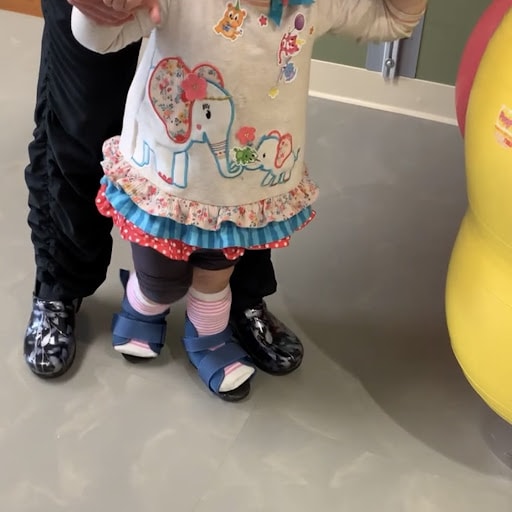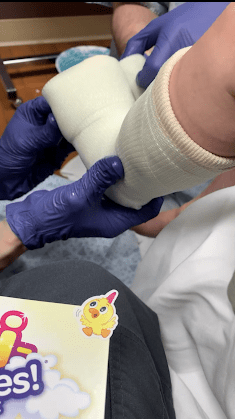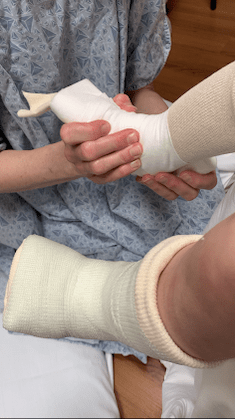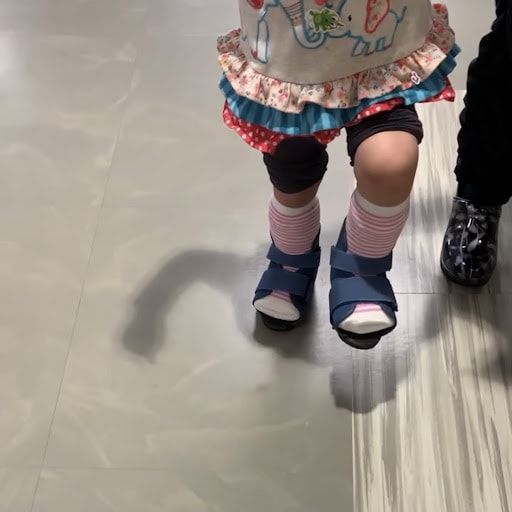What is Pediatric Serial Casting?
Hey everyone! If you’ve ever heard of pediatric serial casting, it probably sounded pretty scary when it was described to you, especially if it was recommended for your child. The good news is that our pediatric therapy specialists are a great resource for you to ask any question you have about this treatment option. In the meantime, below is some information about serial casts and why it’s an option to help kiddos explore and play with more movement!
Serial casting is an intervention utilized to stretch a muscle that is profoundly tight and causes a loss of range of motion. It consists of the application of a series of individually molded casts, made from fiberglass and/or plaster, that hold a specific body part in a stretched position. These casts continue to go further and further into the stretch with each successive casting, and when completed the affected joint should show increased active and passive range of motion (ROM).
What is the goal of serial casting for kids?
This technique can be used to treat any joint that is lacking the appropriate ROM needed to function properly. It is most commonly used for ankles, specifically to counter plantar flexion contractures that commonly present as non-sensory induced toe walking. While the goal is to restore range of motion, pediatric serial casting has some other benefits as well. It can be used to treat the symptoms of a variety of conditions, including, but not limited to, cerebral palsy, spina bifida, and idiopathic toe walking.

What are the benefits of serial casting?
Serial casting stretches a muscle to regain the proper ROM needed for everyday life activities. These casts can help with reducing muscle contractures, temporarily reduce spasticity, improve biomechanical joint alignment, postural alignment, and gait (how you walk). Simply put, these casts provide the optimal position for your child’s body so you don’t have to worry about the way they move while playing. Your kiddo can also often walk with these casts on, so you can go about your life as normal without the casts interfering!

The prolonged stretch provided by the cast lengthens the muscle over time, which allows your child more range to move. This can then improve overall joint position, countering any negative alignment issues that would affect the way your kiddo walks and plays. Muscle spasticity is also addressed with pediatric serial casting due to the prolonged stretch by directly interfering with the muscle contraction that causes spasticity.
When undergoing serial casting, you should realize that one cast is not on for multiple weeks at a time. It is done in a series of shorter windows, meaning there is a small break between the individual casts that usually lasts for one day. This allows you to bathe your kiddo without worry about getting the cast wet.
What is the serial casting process for my child?
Since it’s a series of casts, this means you will have multiple appointments to have the casts put on. On average, each cast will last you about one week before you take it off at home. This process allows the casts to gradually stretch the muscle that is tight, so it is not painful. It can be a bit uncomfortable, especially if your little one is not used to the “stretching” sensation, but that will go away as their muscle gradually lengthens over time. This process continues until you reach the desired range of motion needed, so this can often take anywhere from 3-12 weeks.


What to Expect During Your Child’s Serial Casting
You may be wondering how these serial casts could possibly survive your kiddo’s energy, play habits, and bath time! Don’t fret though, as these casts are made with fiberglass and/or plaster and are quite durable. The clinic that applies the casts will often give you shoes that fit along the bottom of the cast that are held together by velcro for easy removal.

Once the casts are applied, you may notice your child walks a little differently than they usually do while the casts are on. Same idea applies for serial casts on other joints – moving awkwardly is completely expected. Why? Because the serial casts don’t allow for free movement, and the body’s solution is to compensate by moving in greater fashion elsewhere. In the end, just know that this awkward phase means that they are doing their job to change and improve joint mobility.
To help protect your child’s serial casts during bathtime, you can ask for plastic wrap to go around the casts to help waterproof them, or you can grab some shrink wrap from the grocery store. You can use the shrink wrap around the casts – start from the bottom and work your way up (careful, don’t pull it too tight around their leg!), so you can be worry-free while your little one has their bathtime. Be sure to check the casts after bath time as well to ensure that they are dry, if they do get wet inside you will have to take them off to avoid skin issues from developing. You can also choose to wait to bathe your child the day they can take the casts off, or utilize sponge bathing through the week until the day between occurs for full bathing as outlined earlier.
Is Serial Casting Appropriate for Your Child?
If you think your child walks on their toes, has trouble maintaining flat feet when standing or walking, appears to have stiffness in their legs, or frequently trips because they’re up on their toes, a physical therapy or occupational therapy evaluation is recommended. It’s never too late or too early to have your little one assessed. Read more on a parent’s perspective to serial casting in our recent blog. Contact us to schedule an appointment today!
Thanks for taking your time to read this blog. We hope you found this information and interview helpful. Follow us on Facebook to stay up-to-date on blog posts like this and more!
